Our cat Autumn loves the garden as much as we do, though maybe for different reasons. She dreams she is a tiger, slinking through the jungle and stalking her prey. While she stays inside most of the time, we do let her out a few hours each day so she can be a cat.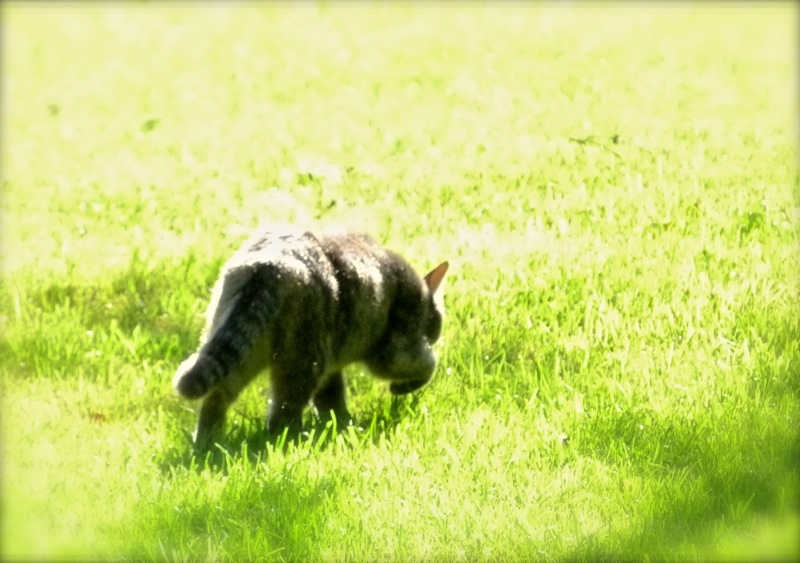 Being a cat.
Being a cat.

 We no longer put up bird feeders, not wanting to give her or our resident hawks easy targets, nor wanting to encourage our pesky chipmunks to hang around. (We have an over-abundant chipmunk population. In the past they built a condominium underneath one of our bird feeders and then sent out fliers advertising its amenities, including free meals. Now a vast underground chipmunk city stretches beneath our garden.) Both the hawks and Autumn hunt chipmunks, but since she has a home and doesn't depend on her prowess for food, Autumn is likely to catch chipmunks simply for play. I watched her do this one day. She repeatedly captured and released a chipmunk just so she could chase after him. I began to feel sorry for him; but apparently she wasn't actually biting him, and in the end he got away.
We no longer put up bird feeders, not wanting to give her or our resident hawks easy targets, nor wanting to encourage our pesky chipmunks to hang around. (We have an over-abundant chipmunk population. In the past they built a condominium underneath one of our bird feeders and then sent out fliers advertising its amenities, including free meals. Now a vast underground chipmunk city stretches beneath our garden.) Both the hawks and Autumn hunt chipmunks, but since she has a home and doesn't depend on her prowess for food, Autumn is likely to catch chipmunks simply for play. I watched her do this one day. She repeatedly captured and released a chipmunk just so she could chase after him. I began to feel sorry for him; but apparently she wasn't actually biting him, and in the end he got away.
Autumn often accompanies me on my garden strolls. I call these our cat walks. We make frequent stops to gaze into space for prolonged periods. I am mentally assessing the garden, while she has her eyes on some imperceptible movement amidst the plants. Clockwise from upper left:African daisy; An old Easter lily that blooms faithfully every year; Hydrangea 'Lady in Red', named for its red stems, not its blooms; Gardenia, whose wonderful fragrance fills the woodland garden each June.I can see the tension building in Autumn's body as she stares. Then she pounces, hoping to catch a chipmunk; but not all movement is made by chipmunks. The other day a snake did not appreciate her aggression and decided to fight back. Autumn made a hasty retreat and stuck close to me for the rest of our walk. I like snakes and leave them alone, because they like to dine on chipmunks, too. I hope that with all these predators, the chipmunks will abandon the area.
Clockwise from upper left:African daisy; An old Easter lily that blooms faithfully every year; Hydrangea 'Lady in Red', named for its red stems, not its blooms; Gardenia, whose wonderful fragrance fills the woodland garden each June.I can see the tension building in Autumn's body as she stares. Then she pounces, hoping to catch a chipmunk; but not all movement is made by chipmunks. The other day a snake did not appreciate her aggression and decided to fight back. Autumn made a hasty retreat and stuck close to me for the rest of our walk. I like snakes and leave them alone, because they like to dine on chipmunks, too. I hope that with all these predators, the chipmunks will abandon the area.
The cat and I pause at the top of the steps leading down into the woodland garden. Pink gumbo azaleas are blooming across from Autumn fern. (I named Autumn after the season, not the plant, because she came to us at that time of year and also because of the autumn colors in her fur.)
Pink gumbo azaleas are blooming across from Autumn fern. (I named Autumn after the season, not the plant, because she came to us at that time of year and also because of the autumn colors in her fur.)
Down the steps is Carex 'Everillo'. I adore this plant! It keeps getting better and better and doesn't mind Autumn's occasional nibbles.
I adore this plant! It keeps getting better and better and doesn't mind Autumn's occasional nibbles.
Next is Pilea glauca, or Red Stemmed Pilea. I love how the steel blue foliage contrasts with its red stems. This is a tropical plant that will come inside for the winter.
I love how the steel blue foliage contrasts with its red stems. This is a tropical plant that will come inside for the winter.
Now we come to the weirdest plant in my garden, Amorphophallus konjac, also called Voodoo plant, Devil's Tongue, and Corpse plant. All of these names are appropriate. The spotted stems feel like human skin. The great leaf opens up like an umbrella and looks a lot like a tomato plant. I have two of these growing in pots in different parts of my garden. They are four years old. It takes about five years till they bloom, so I am looking forward to that experience next year. The blooms are giant maroon things that smell like rotting flesh.
The spotted stems feel like human skin. The great leaf opens up like an umbrella and looks a lot like a tomato plant. I have two of these growing in pots in different parts of my garden. They are four years old. It takes about five years till they bloom, so I am looking forward to that experience next year. The blooms are giant maroon things that smell like rotting flesh.
Well! Just below the Voodoo plant is much nicer Eucomis, or Pineapple lily.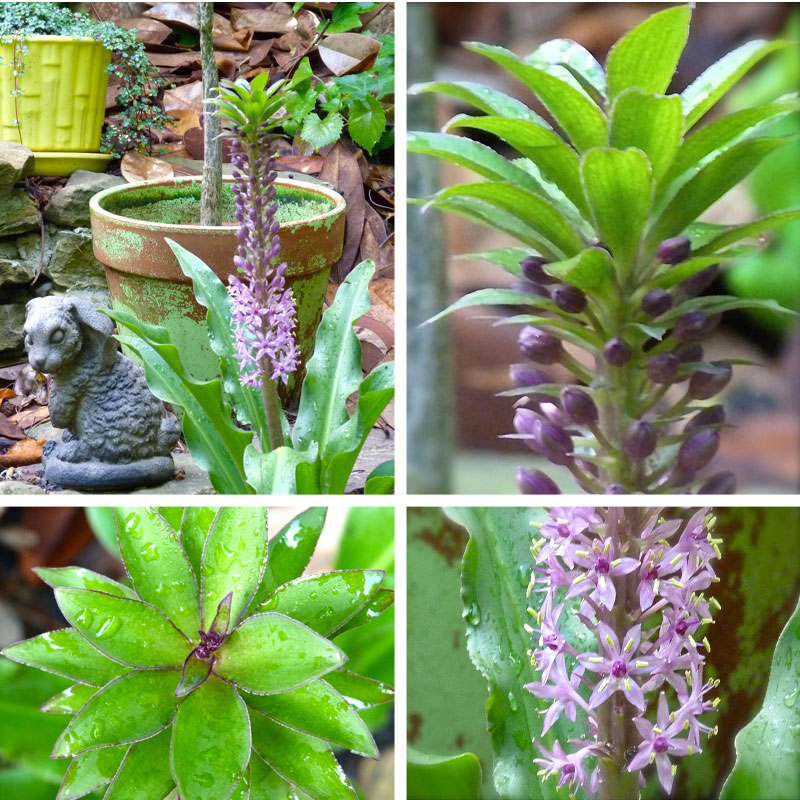 I recently discovered this plant and was thrilled to learn it is hardy in my area (zone 7b/8a). It is my favorite plant of the month. It is just beginning to open its blooms.
I recently discovered this plant and was thrilled to learn it is hardy in my area (zone 7b/8a). It is my favorite plant of the month. It is just beginning to open its blooms.
We continue our cat walk into the woodland garden, where dark shadows and light beams play across moss covered paths. This woodland side path leads around the main planting area in the woodland garden.
This woodland side path leads around the main planting area in the woodland garden.
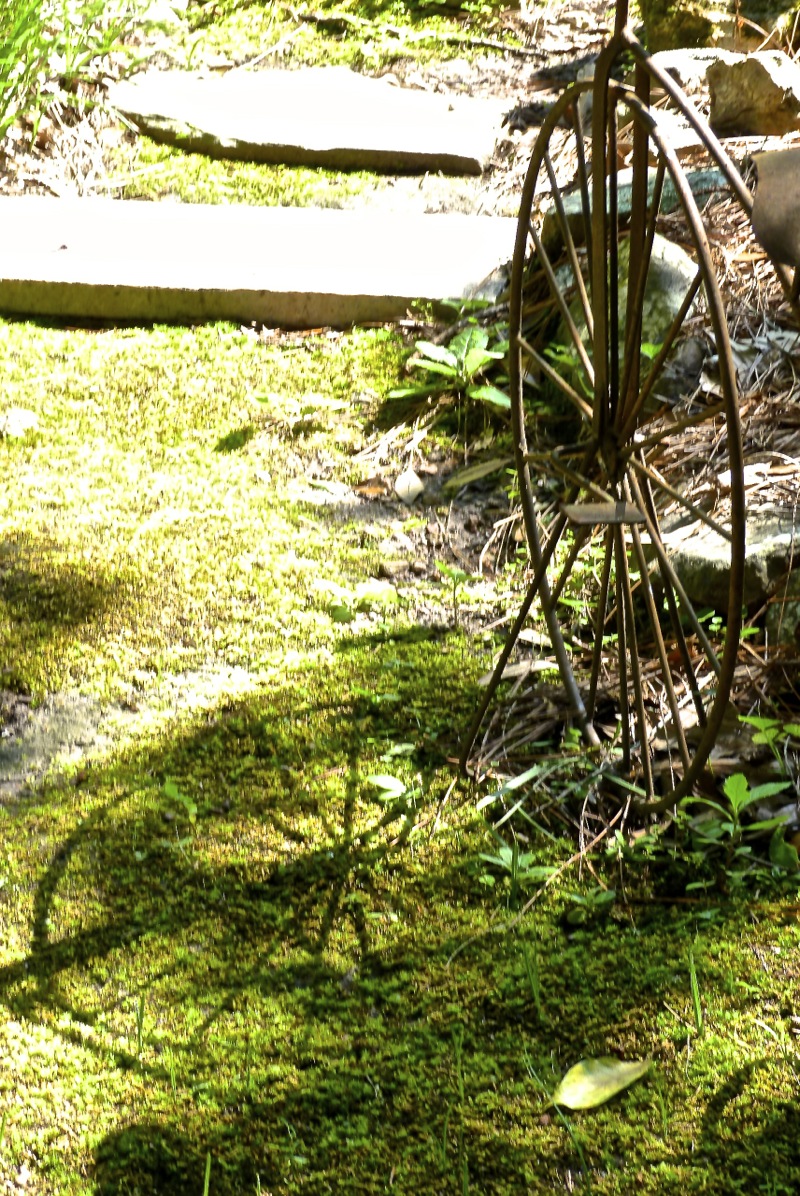 Bicycle shadow in the woodland gardenThe woodland garden is a quiet place, except for the shrieking hawks who built their nest in a pine tree earlier this year. The hawk babies are out of the nest now, but the fledglings are still hanging around, while their parents teach them how to catch chipmunks. All these hawks are talking to each other. It is a hard language to listen to. I tell Autumn they are fussing at her and she had better stay close. She does.
Bicycle shadow in the woodland gardenThe woodland garden is a quiet place, except for the shrieking hawks who built their nest in a pine tree earlier this year. The hawk babies are out of the nest now, but the fledglings are still hanging around, while their parents teach them how to catch chipmunks. All these hawks are talking to each other. It is a hard language to listen to. I tell Autumn they are fussing at her and she had better stay close. She does.
After we leave the woodland garden, Autumn and I make our way back toward the patio. I pause to examine the Confederate Jasmine growing on the new arch. Look on the left side of the arch, and you can see the recovering jasmine vine.The jasmine was severely damaged by winter freezes this year, and we cut it back nearly to the ground and took the opportunity to replace the old dilapidated arch. I miss the mass of jasmine that covered the old arch, but the vine is putting out lots of new growth. A new jasmine vine on the other side of the arch is also growing quickly, so I think by next year they will meet in the middle atop the arch.
Look on the left side of the arch, and you can see the recovering jasmine vine.The jasmine was severely damaged by winter freezes this year, and we cut it back nearly to the ground and took the opportunity to replace the old dilapidated arch. I miss the mass of jasmine that covered the old arch, but the vine is putting out lots of new growth. A new jasmine vine on the other side of the arch is also growing quickly, so I think by next year they will meet in the middle atop the arch.
The cat walk is over, and Autumn and I head into the house. Autumn curls up for a nap. In her dreams she is a mighty tiger on the prowl, and the chipmunks don't stand a chance.
You may also enjoy these previous posts:
Under the Spell of the Voodoo Plant
A Cat Tale
The Cat is Back
Confederate Jasmine For a Fragrant Layer in the Garden
 Saturday, July 12, 2014 at 5:01AM
Saturday, July 12, 2014 at 5:01AM  I had not seen a box turtle in our garden for a couple of years, so I grabbed my camera and went outside. The box turtle was nestled against our walkway by the patio, with his head poking up out of pine straw. I wanted a photo, but I wanted one with a clear view; so I sat down on the walkway and carefully removed most of the pine straw, whereupon he pulled his head into his shell.
I had not seen a box turtle in our garden for a couple of years, so I grabbed my camera and went outside. The box turtle was nestled against our walkway by the patio, with his head poking up out of pine straw. I wanted a photo, but I wanted one with a clear view; so I sat down on the walkway and carefully removed most of the pine straw, whereupon he pulled his head into his shell.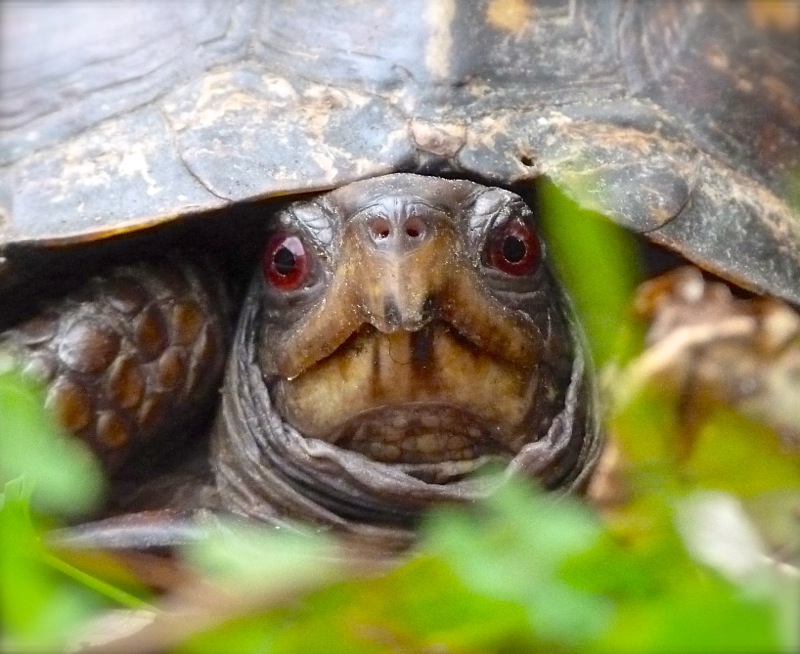
 I was impressed with his nostrils. I also noted his red eyes. Red eyes indicate the turtle is probably a male, whereas females have yellow brown eyes. I have no idea what he thought of me, but he looked me over for about ten minutes. I shot a bunch of photos of his face; I do believe he was posing for me! Then I slowly adjusted my position to shoot some side views.
I was impressed with his nostrils. I also noted his red eyes. Red eyes indicate the turtle is probably a male, whereas females have yellow brown eyes. I have no idea what he thought of me, but he looked me over for about ten minutes. I shot a bunch of photos of his face; I do believe he was posing for me! Then I slowly adjusted my position to shoot some side views. This turtle has been around a while, and he has had at least one close call.
This turtle has been around a while, and he has had at least one close call.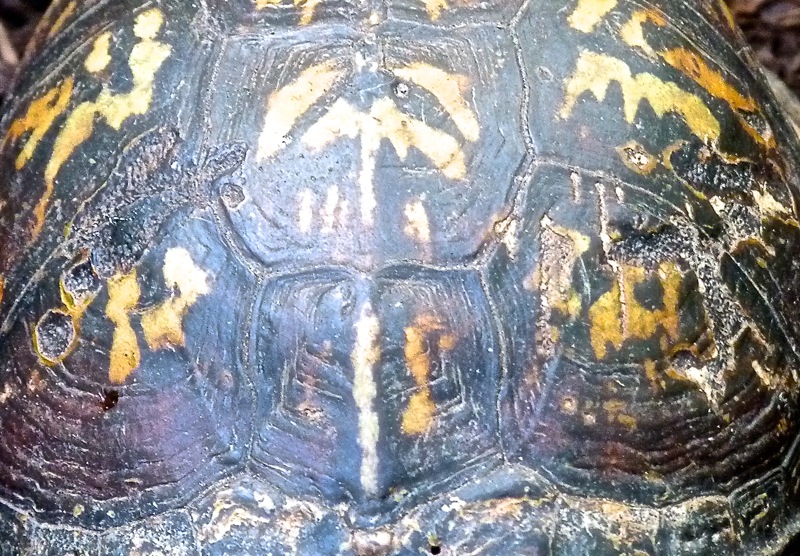 Deep scratches and bite marks are symmetrically placed on both sides of his shell. Was it a raccoon? Or a dog? One thing for sure, he is fortunate to have that tough shell for protection! Young turtles with softer shells often fall victim to predators, but once they reach adulthood, they can live a long time. The average life span of an adult box turtle is fifty years, and it is not uncommon for them to live longer than 100 years! With lots of wear on his shell and a mature countenance, this turtle is no spring chicken! I would not be surprised if he has been around as long as I have.
Deep scratches and bite marks are symmetrically placed on both sides of his shell. Was it a raccoon? Or a dog? One thing for sure, he is fortunate to have that tough shell for protection! Young turtles with softer shells often fall victim to predators, but once they reach adulthood, they can live a long time. The average life span of an adult box turtle is fifty years, and it is not uncommon for them to live longer than 100 years! With lots of wear on his shell and a mature countenance, this turtle is no spring chicken! I would not be surprised if he has been around as long as I have.


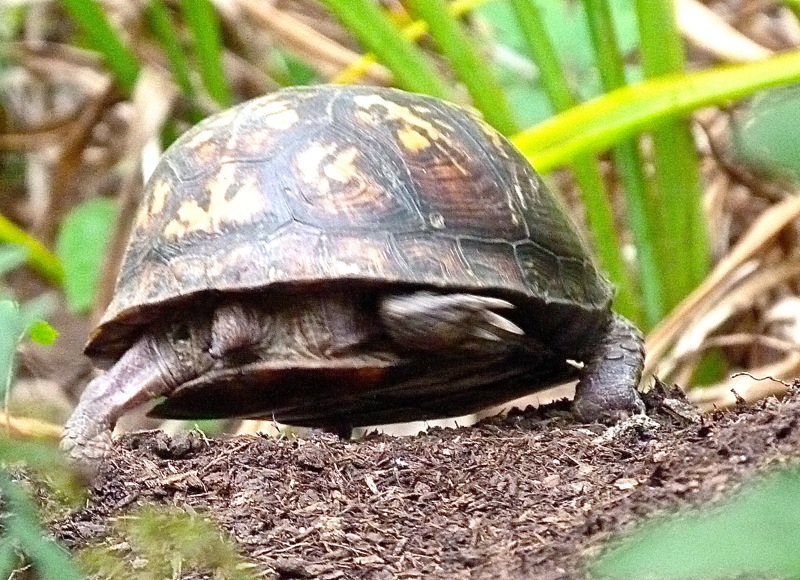
 Box turtle in
Box turtle in  creatures of the garden
creatures of the garden 









